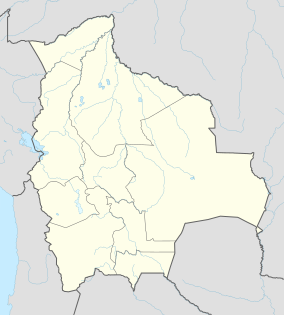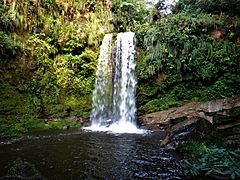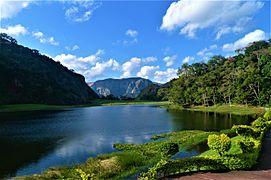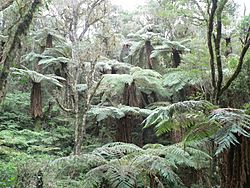Amboró National Park facts for kids
Quick facts for kids Amboró National Park |
|
|---|---|
|
IUCN Category II (National Park)
|
|
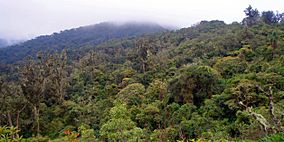 |
|
| Location | Bolivia |
| Area | 4,425 km² |
| Established | 1984 |
| Governing body | Servicio Nacional de Áreas Protegidas (SERNAP) |
Amboró National Park is a special nature reserve in central Bolivia. It's like a giant outdoor classroom, home to an amazing variety of plants and animals. The park covers a huge area of 4,425 square kilometers (about 1,709 square miles).
Amboró is protected from things like hunting, mining, and cutting down trees. Even so, people sometimes still cause problems inside the park. Next to Amboró is another park called Carrasco National Park. Together, they form an even bigger area where nature is kept safe.
Contents
What is Amboró National Park Like?
Where is Amboró Located?
Amboró National Park is in the western part of the Santa Cruz region in Bolivia. It's located where the Andes mountains make a slight bend. This area is often called the "Elbow of the Andes."
Different Types of Nature in the Park
The park is part of the Central Andes area. It protects many different types of natural environments, called ecoregions. These include:
- Wet forests in the Amazon area
- Dry forests in the Chaco region
- Mountain dry forests in Bolivia
- Dry forests in the Chiquitano area
- Yungas forests, which are found at higher elevations
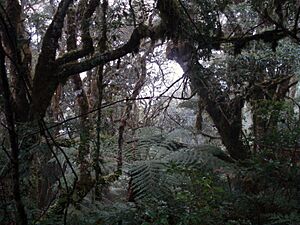
The special shape of the land in Amboró National Park creates a huge variety of plants and animals. The height above sea level in the park changes a lot. It goes from about 300 meters (984 feet) up to 3,338 meters (10,951 feet) in the western part. Most of the park is between 1,000 meters (3,280 feet) and 2,000 meters (6,560 feet) high.
The park also gets a lot of rain. It can get between 1,400 millimeters (55 inches) and 4,000 millimeters (157 inches) of rain each year. Amboró National Park is famous for its beautiful Yungas forests.
How to Visit Amboró National Park
Getting to the Park
Two main roads run along the north and south edges of the park. These roads connect the cities of Cochabamba and Santa Cruz. The southern road used to be paved but is now mostly gravel and dirt. This means fewer cars use it, which helps protect the park.
Smaller gravel roads branch off the main ones. These let you reach the more developed parts of the park's northern and southern areas. You can also walk into the park on small trails and along riverbeds. However, the park's rough mountains make it hard to get around.
Main Entry Points
For the northern part of the park, you can enter from towns like Buena Vista, Santa Fe, and Yapacani. These towns are along the northern road. From there, dirt tracks lead to places like Espejitos, Saguayó, La Chonta, Macuñucu, and the Yapacani river.
For the southern part, you can enter from towns like El Torno, Samaipata, Mairana, Pampa Grande, Mataral, and Comarapa. These towns are on the main highway.
Remember, by law, you must have a guide to enter Amboró National Park.
Gallery
History of Amboró National Park
How the Park Was Created
Amboró National Park was first created in 1973. It was originally called the Reserva de Vida Silvestre German Busch. In 1984, with help from people like biologist Noel Kempff, the park officially became a national park. It started by protecting 1,800 square kilometers.
Later, in 1991, the park grew much larger to 6,376 square kilometers. However, in 1995, its size was changed again to 4,425 square kilometers.
Managing the Park
Over the years, different groups have helped manage Amboró National Park. In 1989, a local group started looking after the park. They counted plants and animals, checked on people living nearby, and shared information about the park. They also built ranger stations to help protect the area.
In 1991, a group called Fundación Amigos de la Naturaleza (FAN) started helping. They worked with the government to manage the park. When the park's size was greatly increased in 1991, some local people were upset. This was because their land was included without asking them first.
To solve this, a special "Red Line" was created in 1995. This line marked the boundary between the National Park (where nature is strictly protected) and an "Integrated Management Natural Zone." In this second zone, people could use the land in certain ways, but still protect nature. This helped reduce conflicts.
Today, the Bolivian government is in charge of managing Amboró National Park.
Plants of Amboró National Park
Amboró National Park is one of the richest places in the world for plants. So far, about 3,000 different types of plants have been found here. But scientists believe there are many more waiting to be discovered!
The park's varied landscape helps create this huge plant diversity. You can find many types of forests, like lowland forests, mountain forests, and cloud forests. There are also areas with scrublands, grasslands, cactus forests, and palm forests. Some parts even have cliffs covered in special plants or forests made almost entirely of giant tree ferns.
Why So Many Plants?
Amboró is special because it sits where several different plant regions meet. These include:
- The tropical Amazon lowlands
- The high Andes mountains
- Subtropical forests
- Dry valleys and wet tropical forests
Because the park's terrain is so difficult to explore, many parts have never been fully studied by botanists. This means there are likely many new plant species to find. Some of these might even be unique to Amboró, meaning they are found nowhere else in the world!
Interesting Plants in Amboró
Some of the important and interesting plants found in the park include:
- Bigleaf mahogany
- Mountain pine
- Black walnut
- Tree ferns, especially in the cloud forests
- Pachiuva and açaí palms
- Many types of unique orchids
Animals of Amboró National Park
Amboró National Park is also home to an incredible number of animals.
Mammals
Scientists have recorded 177 different types of mammals in the park. This includes 43 different kinds of bats! Some of the larger mammals you might find are:
- The spectacled bear, also known as the jucumari
- The powerful jaguar
- The giant anteater
Amphibians and Reptiles
The park has a very high number of unique amphibians and reptiles. There are 173 species of amphibians, including 50 types of toads! Plus, there are 135 different species of reptiles.
Birds
More than 912 species of birds have been seen in Amboró. This is over 60% of all the bird species found in Bolivia! Two of the most interesting birds are the southern helmeted curassow and the colorful military macaw.
Fish
In just one part of the park, 109 species of fish have been found. The types of fish depend on how high up in the park you are. Larger fish, like sábalo, barred surubim, and pacú, are found in the lower areas, below 700 meters (2,296 feet). As you go higher, the number of different fish species drops a lot.
People Living Near Amboró
People live in the areas surrounding Amboró National Park. In the northern part, settlements were started by people from the highlands. In the south, farmers from the valleys live there. Towards the east, you can find Guaraya communities.
Around the park, there are also colorful towns like Samaipata, Comarapa, and Buena Vista.
See also
 In Spanish: Parque nacional Amboró para niños
In Spanish: Parque nacional Amboró para niños


